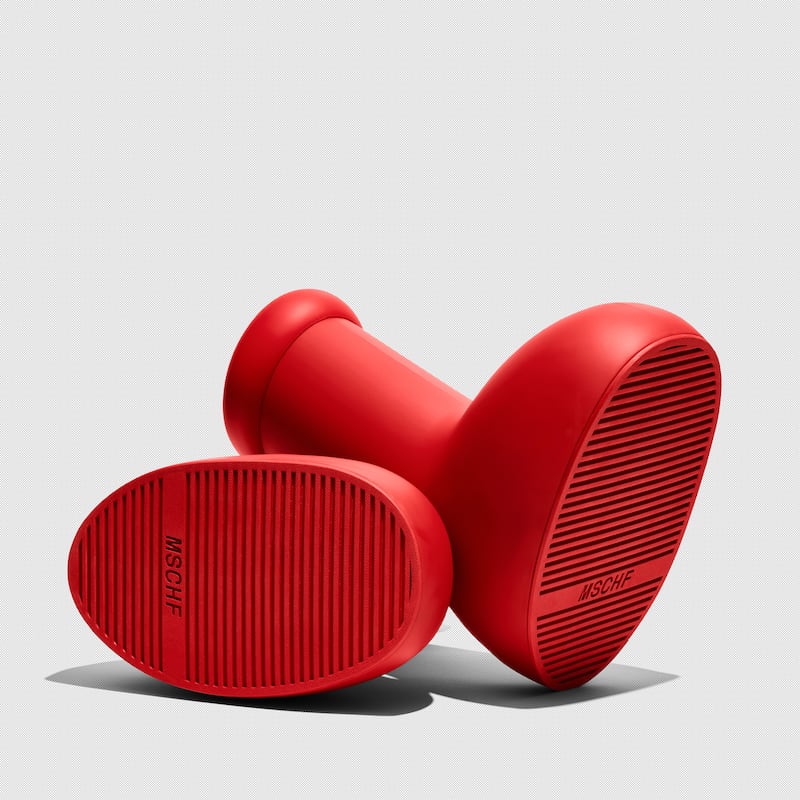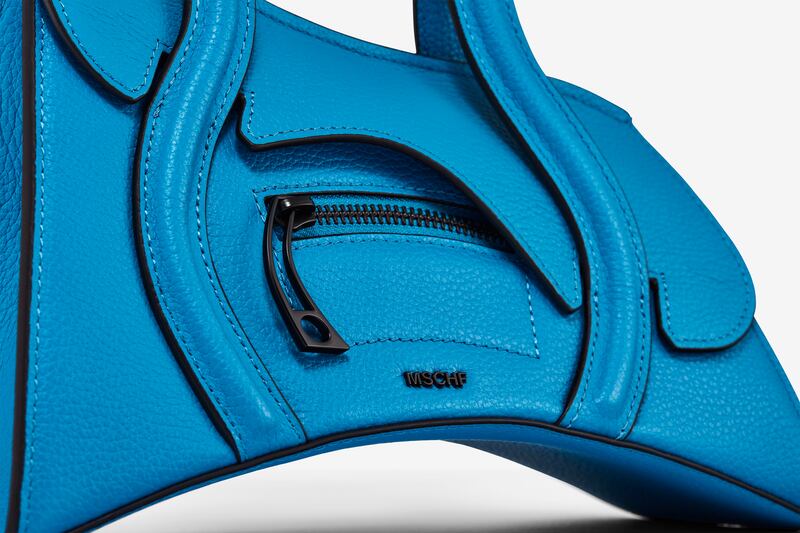February is often a dreary month – so a bit of fashion joy is always going to go down well. Enter, the global supply chain handbag.
It might not sound like a barrel of laughs but, this new design, a kind of Frankenstein of different It-bags – the Birkin, the Celine luggage bag, the Dior saddle bag and the Balenciaga hourglass handbag – is the work of Brooklyn-based company MSCHF. It is wonky, misproportioned and – to the right eyes – a witty comment on where we are at with the It-bag in 2024.

To give you some context, MSCHF (pronounced “mischief”) is the group responsible for the Big Red Boot, which boinged its way across 2023 to the sound of laughter. Very much how they sound, the Big Red Boots were oversized and bright, something like the footwear worn by Japanese cartoon Astro Boy, or Sonic the Hedgehog. But, if those were literal cartoons, the Big Red Boots could be worn in the real world – and they were, by celebrities including Janelle Monáe, Lil Nas X and wrestler Seth Rollins, as well as hordes at New York fashion week. Ridiculous but also hard to ignore, that’s the sweet spot for fashion on the internet. It’s no wonder they went viral.
Unafraid to repeat a punchline, MSCHF then launched the big yellow boot in collaboration with Crocs last summer, with Paris Hilton in the campaign. Victoria Beckham – always keen for an opportunity to show she has a sense of humour – wore the boots, so did controversial rapper and influencer Tommy Cash. MSCHF became a name to know. It now has 806,000 followers on Instagram, despite only 32 posts.
Dancing with the Stars: ‘I’ve had the best time of my life. I feel super fit,’ chef Kevin Dundon says as he is voted off show
Oscars 2025 red carpet: Ariana Grande sets the standard while Timothée Chalamet stood out in ‘Kerrygold’ yellow
Róisín Ingle puts a Thermomix to the test: ‘I am a convert but there’s one enormous catch’
Life without children: ‘I’d want the investment my mother had, but I don’t have it in me. I don’t have the grá for it’
Two of the founders – Lukas Bentel and Kevin Wiesner, who are chief creative officers – worked in conjunction with four factories across the world to make the global supply chain handbag. They asked a factory in Peru to make a knock-off Birkin. With that sample, they went to a factory in Portugal and asked them to make it a bit more Celine, sending them a blurry picture of the brand’s luggage bag. And so on, in India and China.

The project reads like a comment on the growth of bootlegs and dupes in fashion now, but Wiesner, speaking over video call from their New York offices, says it actually comes from a different place. “One thing we’re always so amazed by is the creativity that comes out of the half of the process when producing an object [in a factory]. They are creative problem-solving. This project is about protagonising them.” Dani Levi, Kim Kardashian’s stylist, appears in the campaign images – the idea being that, again, the person behind the finished product (be it a Kardashian or a handbag) is in the spotlight.
If their work sounds like stunts, that’s because it principally is. Because MSCHF is not a brand in the traditional sense. In fact, the duo have been dubbed “the Banksy of the internet”.
Bentel says: “I think the best way to describe it is an artists’ collective. We met in an art school environment, and I think that when we’re making objects, we’re really looking at making things for conceptual reasons. MSCHF projects are performance art pieces and the objects are artefacts of that performance, more than the singular end result.”
We have very consciously always been trying to make work we can push into the actual spaces, and operate at the same scales as the companies and businesses that we’re trying to either critique or have conversations with
— Lukas Bentel - founder
MSCHF “drop” these so-called artifacts of performance on a scarily frequent basis – around every two-and-a-half weeks. With an absurdist bent that plays well online and the occasional tangent towards more serious issues, they vary wildly from an extremely bad taste toaster-shaped bath bomb “to die for”, to a weekly newsletter of emails sent by boomers, an exhibition of blown-up medical bills sold as artworks to rid the patients of medical debt, and a cologne that smells like WD-40. The global supply chain telephone bag is the 101st release. Each has its own bespoke website and, if it’s based around a product, a limited release (they decline to provide numbers).

Bentel and Wiesner say they are inspired by a range of influences, from art prankster Maurizio Cattelan to Andy Warhol and K Hole, the experimental trend forecasting collective that came up with the idea of Normcore in 2013. Fashion provides particularly fertile ground for their tastes, partly because it exists in the day-to-day. “A lot of artists don’t operate like that,” says Bentel. “They make work critical of something and they put it in a gallery space and only the people in that space interact with it. We have very consciously always been trying to make work we can push into the actual spaces, and operate at the same scales as the companies and businesses that we’re trying to either critique or have conversations with.” The virality helps with this – although they can’t always predict it. Even the big red boots surprised them. “There’s always a tipping point where we realise it’s out of our hands [in terms of popularity], you can never design 100% for it,” says Bental.
[ Simone Gannon: Four new make-up products with transformative powersOpens in new window ]
MSCHF was set up by Bentel, Wiesner, Gabriel Whaley, Stephen Tetreault and Ramdane Sennoun in 2016. In 2020, the New York Times reported it had $11.5 million (€10.7m) in outside investment and 10 employees. It now has about 30. Bentel and Wiesner became friends at Rhode Island School of Design, and still have the energy of art students (Wiesner’s T-shirt reads simply “tomato”, and there’s a manga-style poster in the background featuring a nude cartoon with blue hair). Their first drop was called The Persistence of Chaos, and focused on finance. Created with artist Guo O Dong, it was a webpage live-streaming the screen of a laptop loaded with six pieces of malware that had previously caused $95 billion worth of damage. They sold the laptop for $1.3m at auction.
We were sort of trying to make fun of sneaker culture
— Kevin Wiesner - founder
But it was their seventh drop – $1,425 (€1,130) sneakers designed to be a collaboration with Jesus, and containing holy water in the soles – that first garnered more widespread attention. They sold out in minutes and were on listed on the American resale site popular with sneaker-heads, StockX, for £3,000 (€3,526). “We were sort of trying to make fun of sneaker culture,” says Wiesner. “We never in a million years would have thought they would have engaged with it.”
The experience, however, had them hooked. Two years later, they released Satan shoes in a limited run of 666, a collaboration with rapper Lil Nas X; they came with blood in the air bubble. Selling out in less than a minute, outrage was part of it – the evangelical pastor Mark Burns described the sneakers as “evil” and “heresy”. Nike, who made the Air Max 97 trainers that MSCHF used, sued for trademark infringement. In 2021 they settled, and the sports company tried to remove the shoes from resale sites. A condition of the settlement stipulated that MSCHF had “to offer everyone a refund at cost if they want it,” says Wiesner. “But the funny thing was at that time on secondary market platforms, they were going for four or five times their actual value … you’d be taking a bath if you took the refund.” The very MSCHF conceit of creating arguably absurd objects, going viral, making the status quo look ridiculous and moving on to the next project had begun. Soon to follow were those Big Red Boots and literally microscopic handbags.

But, if a lot of MSCHF’s work is centred around a spiky, ironic sense of humour sending up the artifice of consumption and the role of corporations in our lives, Bentel and Wiesner’s favourite project is something a little more heartwarming. Key4All in 2022 allowed 5,000 people to buy a key to a single car and drive it – if they could find it in New York. “It has driven all the way from New York to California, just from people taking the car from each other, stealing it, sharing it, and there was this crazy community that built up around it,” says Bentel. “A project like that maybe doesn’t have a tremendous level of reach, but in terms of actual impact, a small group of 5,000 people have co-ownership over this car [and that] is incredibly beautiful.” Artifacts of performance that come with all the feels? Maybe it’s the future of MSCHF. - Guardian












